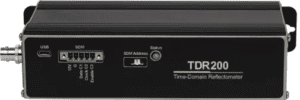The TDR200 Time-Domain Reflectometer is the core of the Buraq Integrated Solutions time-domain reflectometry (TDR) system. TDR systems accurately determine soil volumetric water content, soil bulk electrical conductivity, rock mass deformation, or a user-specific time-domain measurement. One Campbell Scientific data logger can control multiple TDR200 reflectometers.

The TDR200 generates a short rise time electromagnetic pulse that is applied to a coaxial system that includes a TDR probe for soil water measurements. Then the reflectometer samples and digitizes the resulting reflection waveform for analysis or storage.
The elapsed travel time and pulse reflection amplitude contain information used by the on-board processor to quickly and accurately determine soil volumetric water content, soil bulk electrical conductivity, rock mass deformation, or a user-specific time-domain measurement.
The data logger collects a 250-point waveform and analyzes it in approximately two seconds. Each waveform can have up to 10,112 data points for monitoring long cable lengths used in rock mass deformation or slope stability. Advanced noise filtering and averaging make accurate measurements possible in noisy environments.
A Complete System
A complete TDR200-based system includes the TDR200, SDM8X50 multiplexers, data logger, power supply, enclosures, and probes. PC-TDR version 3 software supports TDR200 and sensor setup, troubleshooting, and program generation.
The SoilVUE™10 consists of TDR circuitry connected to a series of six or nine helical wave guides that make up part of the overall threaded design. The threaded design with individual sensors built into the threads improves sensor contact with the soil to reduce potential error from air gaps. The TDR circuitry generates a short rise time electromagnetic pulse that is applied to the helical wave guides. The elapsed two-way travel time of the applied pulse is used to calculate the dielectric permittivity of the surrounding media and determine the volumetric water content using a mixing model.
The soil water content profile sensor can be installed in a hole made by a standard 5 cm (2 in.) hand auger. Excavation machinery or expensive custom tools are not necessary to install the sensor.
The included cable has an IP67 rated M12 connector that is detachable from the sensor for easy field replacement if the cable becomes damaged.
Benefits and Features
- Measures VWC, permittivity, EC, and temperature
- Six or nine depths measured with one sensor
- Quick and low-impact installation
- Digital output is compatible with most Campbell Scientific data loggers
- Designed for long-term outdoor operation
- True-Wave ™ TDR technology is proven and trusted
SPECIFICATIONS
| Measurements Made | Volumetric water content (VWC), permittivity, electrical conductivity (EC), and temperature |
| Operating Temperature Range | -40° to +60°C |
| Maximum Installation Torque | 54 N m (40 ft⋅ lb.) |
| Operating Voltage Range | 9 to 36 Vdc |
| Diameter | · 5.2 cm (2.05 in.) without threads · 5.8 cm (2.3 in.) including threads |
| Maximum cable length | 304.8 m (1,000 ft) |
| Length | 0.55 m/1.05 m (21.5 in./41.2 in.) depending on the option ordered |
| Weight | 1.9 kg/3.6 kg (4.2 lb. /7.9 lb.) depending on the option ordered |
| Current Drain | |
| Active | ~64 mA (@ 12 Vdc) |
| Quiescent | ~1.5 mA (@ 12 Vdc) |
| Measurement depths | |
| 0.5 m Option | 5, 10, 20, 30, 40, and 50 cm (2, 4, 8, 12, 16, and 20 in.) |
| 1 m option | 5, 10, 20, 30, 40, 50, 60, 75, and 100 cm (2, 4, 8, 12, 16, 20, 24, 30, and 40 in.) |
| Electrical Conductivity | |
| Range | 0 to 10 dS/m |
| Accuracy | · ±2% (0 to 2.5 dS/m) · ±5% (full range) |
| Relative dielectric permittivity | |
| Range | 1 to 80 |
| Water content accuracy | ±1 permittivity unit (between 4 and 42 permittivity) |
| Soil temperature | |
| Accuracy | ± 0.15°C (between -30° and +40°C) |
| Volumetric Water Content | |
| Range | 0 to 100% |
| Water Content Accuracy | ±1.5% typical with most soils
Soils with high organic matter (> 12% soil organic carbon) or high clay content (> 45% clay) may need a soil-specific calibration due to the dispersive nature of these materials. |
